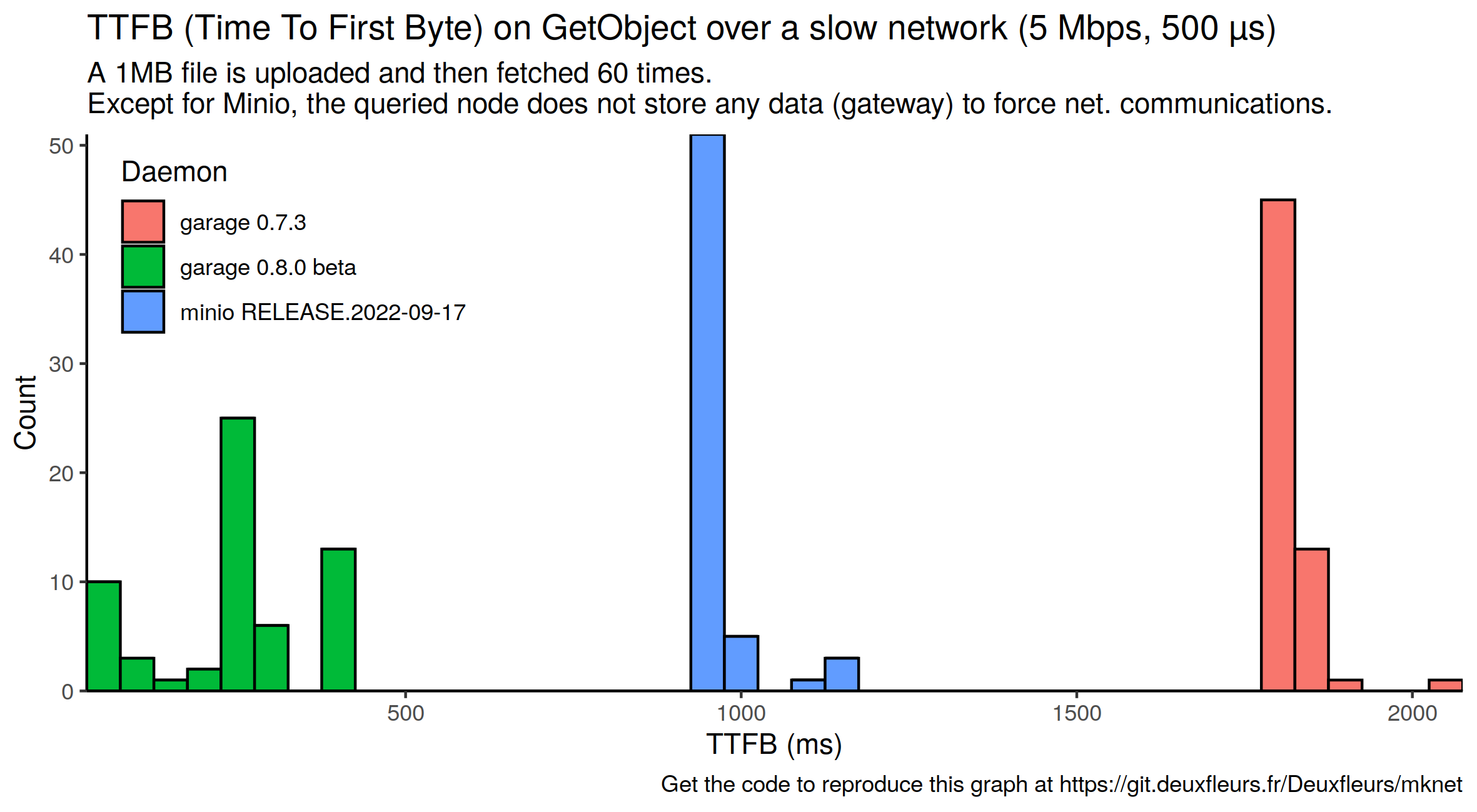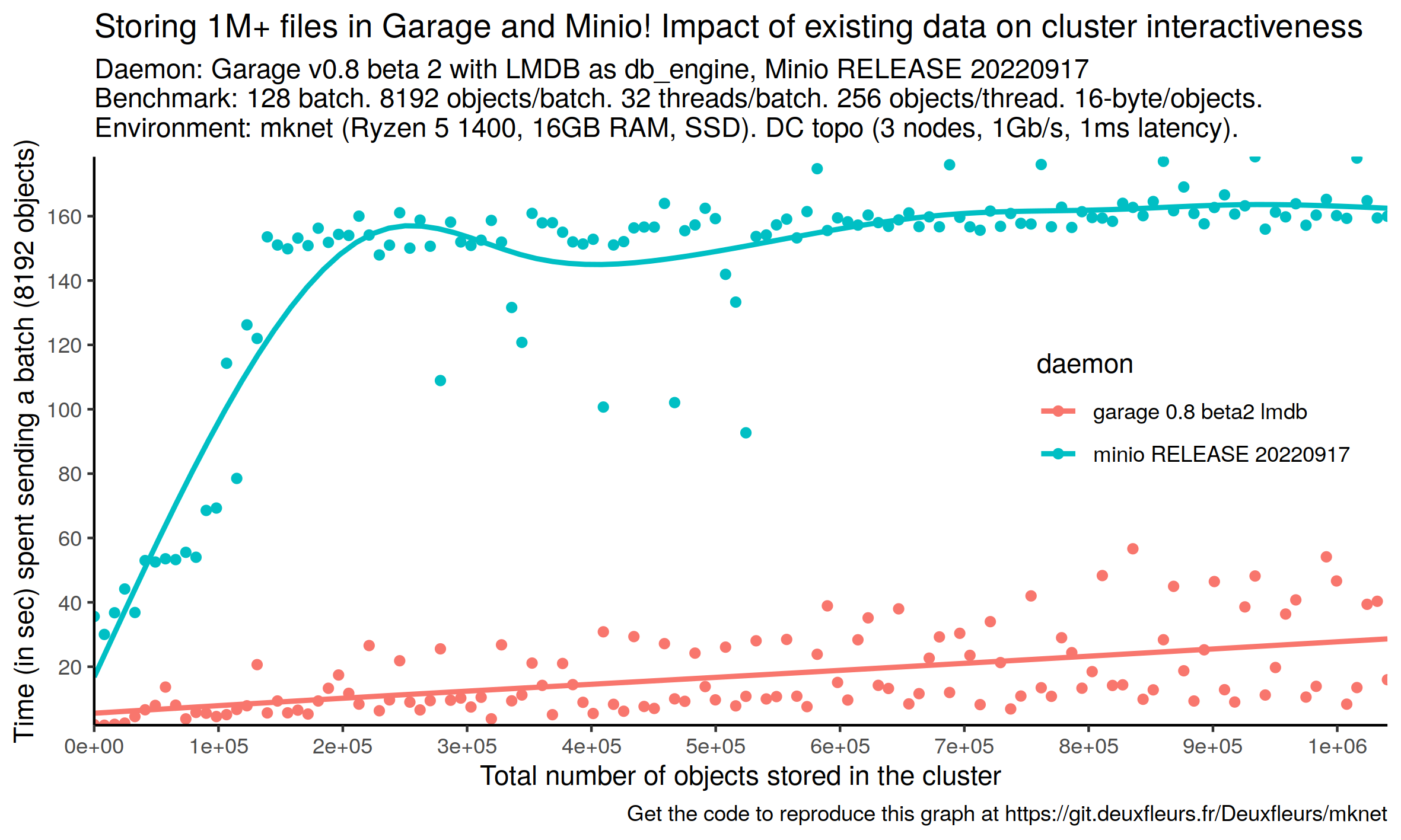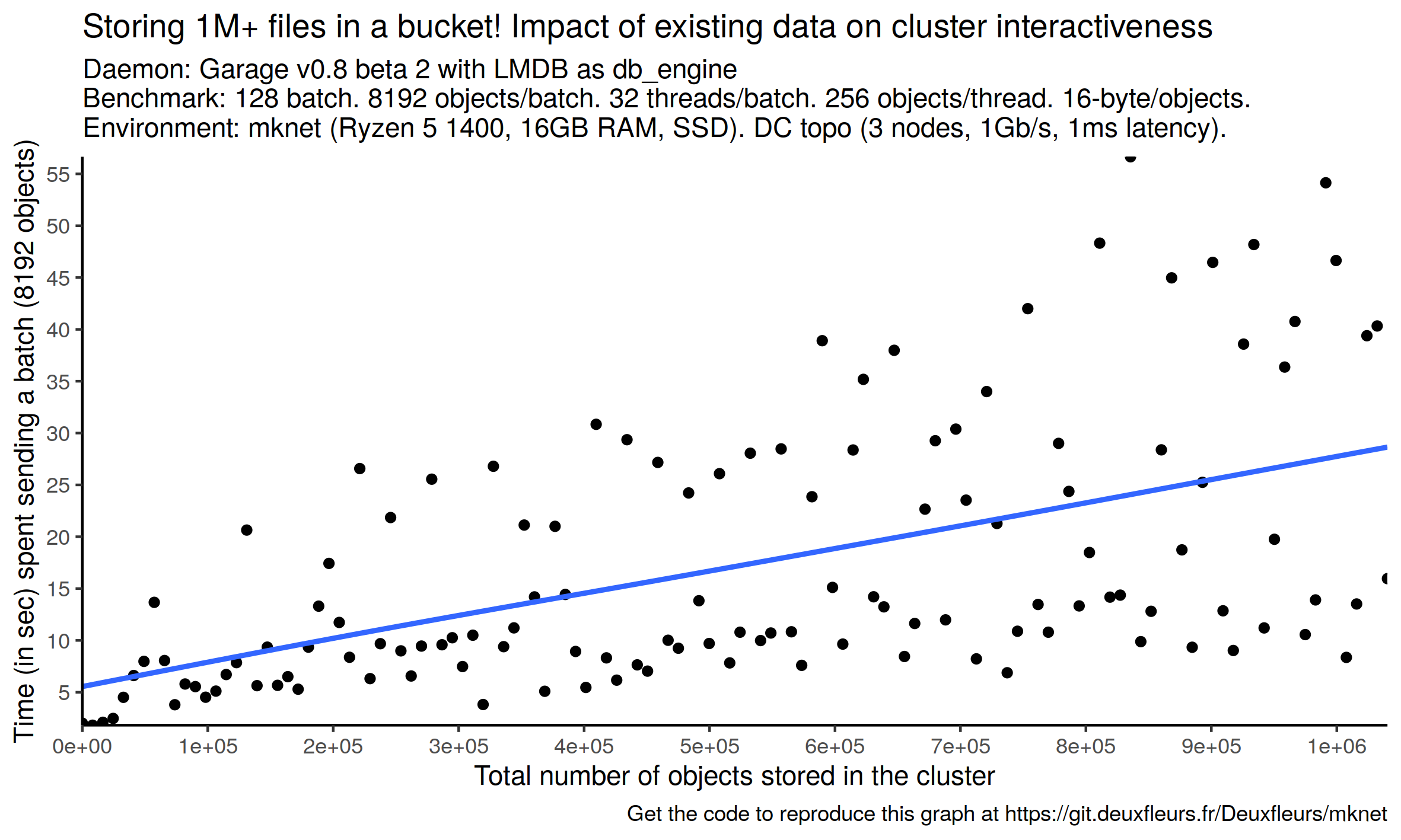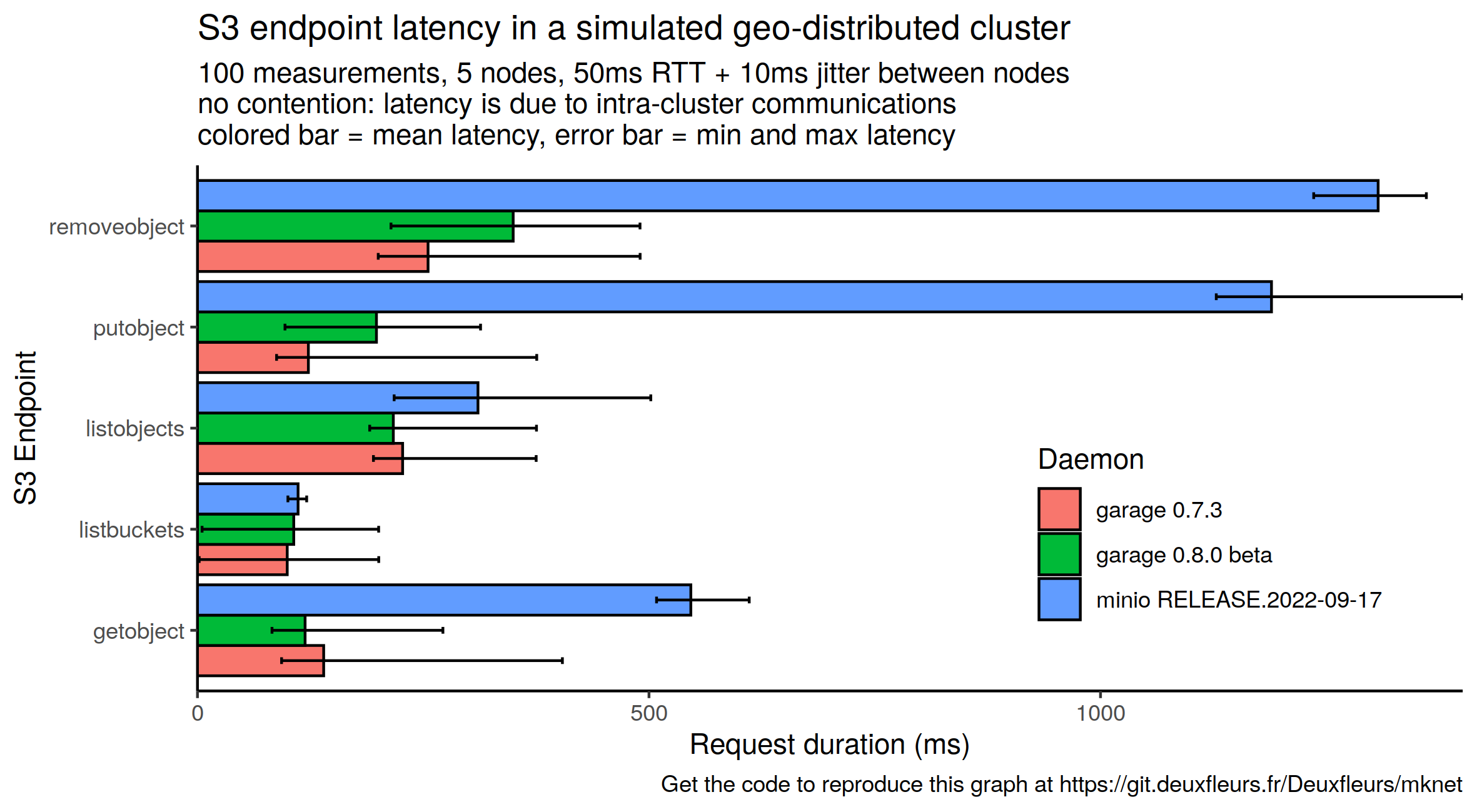22 KiB
+++ title="Bringing theoretical design and observed performances face to face" date=2022-09-26 +++
For the past years, we have extensively analyzed possible design decisions and their theoretical tradeoffs on Garage, being it on the network, data structure, or scheduling side. And it worked well enough for our production cluster at Deuxfleurs, but we also knew that people started discovering some unexpected behaviors. We thus started a round of benchmark and performance measurement to see how Garage behaves compared to our expectations.
⚠️ Disclaimer
The following results must be taken with a critical grain of salt due to some limitations that are inherent to any benchmark. We try to reference them as exhaustively as possible in this section, but other limitations might exist.
Most of our tests are done on simulated networks that can not represent all the diversity of real networks (dynamic drop, jitter, latency, all of them could possibly be correlated with throughput or any other external event). We also limited ourselves to very small workloads that are not representative of a production cluster. Furthermore, we only benchmarked some very specific aspects of Garage, on which we are currently working on: our results are thus not an overview of the whole software performances.
For some benchmarks, we used Minio as a reference. It must be noted that we did not try to optimize its configuration as we have done on Garage, and more generally, we have way less knowledge on Minio than on Garage, which can lead to underrated performance measurements for Minio. It must also be noted that Garage and Minio are systems with different feature sets, eg. Minio supports erasure coding for better data density while Garage doesn't, Minio implements way more S3 endpoints than Garage, etc. Such feature have necessarily a cost that you must keep in mind when reading plots. You should consider Minio results as a way to contextualize our results, to check that our improvements are not artificials compared to existing object storage implementations.
Impact of the testing environment is also not evaluated (kernel patches, configuration, parameters, filesystem, hardware configuration, etc.), some of these configurations could favor one configuration/software over another. Especially, it must be noted that most of the tests were done on a consumer-grade computer and SSD only, which will be different from most production setups. Finally, our results are also provided without statistical tests to check their significance, and thus might be statistically not significative.
When reading this post, please keep in mind that we are not making any business or technical recommendation here, this is not a scientific paper either; we only share bits of our development process as honestly as possible. Read benchmarking crimes, make your own tests if you need to take a decision, and remain supportive and caring with your peers...
About our testing environment
We started a batch of tests on Grid5000, a large-scale and flexible testbed for experiment-driven research in all areas of computer science, under the Open Access program. During our tests, we used part of the following clusters: nova, paravance, and econome to make a geo-distributed topology. We used the Grid5000 testbed only during our preliminary tests to identify issues when running Garage on many powerful servers, issues that we then reproduced in a controlled environment; don't be surprised then if Grid5000 is not mentioned often on our plots.
To reproduce some environments locally, we have a small set of Python scripts named mknet tailored to our needs1. Most of the following tests where thus run locally with mknet on a single computer: a Dell Inspiron 27" 7775 AIO, with a Ryzen 5 1400, 16GB of RAM, a 512GB SSD. In term of software, NixOS 22.05 with the 5.15.50 kernel is used with an ext4 encrypted filesystem. The vm.dirty_background_ratio and vm.dirty_ratio have been reduced to 2 and 1 respectively as, with default values, the system tends to freeze when it is under heavy I/O load.
Efficient I/O
Time To First Byte - One specificity of Garage is that we implemented S3 web endpoints, with the idea to make it the platform of choice to publish your static website. When publishing a website, one metric you observe is Time To First Byte (TTFB), as it will impact the perceived reactivity of your website. On Garage, time to first byte was a bit high.
This is not surprising as, until now, the smallest level of granularity was blocks. Blocks are 1MB chunks (this is configurable) of a given object. For example, a 4.5MB object will be split in 4 blocks of 1MB and 1 block of 0.5MB. With this design, when you were sending a GET request, the first block had to be fully retrieved by the gateway node from the storage node before starting sending any data to the client.
With Garage v0.8, we integrated a block streaming logic which allows the gateway to send the beginning of a block without having to wait for the full block from the storage node. We can visually represent the difference as follow:
As our default block size is only 1MB, the difference will be very small on fast networks: it takes only 8ms to transfer 1MB on a 1Gbps network. However, on a very slow network (or a very congested link with many parallel requests handled), the impact can be much more important: at 5Mbps, it takes 1.6 second to transfer our 1MB block, and streaming could heavily improve user experience.
We wanted to see if this theory helds in practise: we simulated a low latency but slow network on mknet and did some request with (garage v0.8 beta) and without (garage v0.7) block streaming. We also added Minio as a reference.
As planned, Garage v0.7 that does not support block streaming features TTFB between 1.6s and 2s, which correspond to the computed time to transfer the full block. On the other side of the plot, we see Garage v0.8 with very low TTFB thanks to our streaming approach (the lowest value is 43 ms). Minio sits between our 2 implementations: we suppose that it does some form of batching, but on less than 1MB.
Read/write throughput - As soon as we publicly released Garage, people started benchmarking it, comparing its performances to writing directly on the filesystem, and observed that Garage was slower (eg. #288). To improve the situation, we put costly processing like hashing on a dedicated thread and did many compute optimization (#342, #343) which lead us to v0.8 beta 1. We also noted logic we wrote (to better control resources usage and detect errors, like semaphore or timeouts) were artificially limiting performances. In another iteration, we made this logic less restrictive at the cost of higher resource consumption under load (#387), resulting in v0.8 beta 2. Finally, we currently do multiple fsync calls each time we write a block. We know that this is expensive and did a test build without any fsync call (see the commit) that will not be merged, just to assess the impact of fsync. We refer to it as no-fsync in the following plot.
A note about fsync: for performance reasons, operating systems often do not write directly to the disk when a process creates or updates a file in your filesystem, instead, the write is kept in memory, and flushed later in a batch with other writes. If a power loss occures before the OS has time to flush the writes on the disk, data will be lost. To ensure that a write is effectively written on disk, you must use the fsync(2) system call: it will block until your file or directory has been written from your volatile RAM memory to your persisting storage device. Additionaly, the exact semantic of fsync differs from one OS to another and, even on battle-tested software like Postgres, they "did it wrong for 20 years". Note that on Garage, we are currently working on our "fsync" policy and thus, for now, you should expect limited data durability in case of power loss, as we are aware of some inconsistency on this point (which we describe in the following and plan to solve).
To assess performance improvements, we used the benchmark tool minio/warp in a non-standard configuration, adapted for small scale tests, and we kept only the aggregated result named "cluster total". The goal of this experiment is to get an idea of the cluster performance with a standardized and mixed workload.
Minio, our ground truth, features the best performances in this test. Considering Garage, we observe that each improvement we made has a visible impact on its performances. We also note that we have a progress margin in term of performances compared to Minio: additional benchmarks, test and monitoring could help better understand the remaining difference.
A myriad of objects
Testing metadata engines - With Garage, we chose to not store metadata directly on the filesystem, like Minio for example, but in an on-disk fancy B-Tree structure, in other words, in an embedded database engine. Until now, the only available option was sled, but we started having serious issues with it, and we were not alone (#284). With Garage v0.8, we introduce an abstraction semantic over the features we expect from our database, allowing us to switch from one backend to another without touching the rest of our codebase. We added two additional backends: lmdb (heed) and sqlite (rusqlite). Keep in mind that they are both experimental: contrarily to sled, we have never run them in production for a long time.
Similarly to the impact of fsync on block writing, each database engine we use has its own policy with fsync. Sled flushes its write every 2 seconds by default, this is configurable). lmdb by default does an fsync on each write, on early tests it lead to very slow resynchronizations between nodes. We added 2 flags: MDB_NOSYNC and MDB_NOMETASYNC that basically deactivate fsync. On sqlite, it is also possible to deactivate fsync with pragma synchronous = off;, but we did not start any optimization work on it: our sqlite implementation fsync all the data on the disk. Additionaly, we are using these engine through a Rust binding that had to do some tradeoff on the concurrency part. Our comparison will not reflect the raw performances of these database engine, but instead, our integration choices.
Still, we think it makes sense to evaluate our implementations in their current state in Garage. We designed a benchmark that is intensive on the metadata part of the software, ie. handling tiny files. We chose again minio/warp but we configure it with the smallest possible object size supported by warp, 256 bytes, to put some pressure on the metadata engine. We evaluate sled twice: with its default configuration, and with a configuration where we set a flush interval of 10 minutes to disable fsync.
Note that S3 has not been designed for such small objects; a regular database, like Cassandra, would be more appropriate for such workloads. This test has only be designed to stress our metadata engine, it is not indicative of real world performances.
Unsurprinsingly, we observe abysall performances for sqlite, the engine we have the less tested and kept fsync for each write. lmdb performs twice better than default sled and 60% better than no fsync sled in our benchmark. Additionaly, and not depicted on these plots, LMDB uses way less disk storage and RAM; we would like to quantify that in the future. As we are only at the very beginning of our work on metadata engine, it is hard to draw strong conclusions. Still, we can say that sqlite is not ready for production workloads, LMDB looks very promising both in term of performances and resource usage, it is a very good candidate for Garage's default metadata engine in the future, and we need to define a data policy for Garage that would help us arbitrate between performances and durability.
To fsync or not to fsync? Performance is nothing without reliability, so we need to better assess the impact of validating a write and then losing it. Because Garage is a distributed system, even if a node loses its write due to a power loss, it will fetch it back from the 2 other nodes storing it. But rare situations where 1 node is down and the 2 others validated the write and then lost power can occure, what is our policy in this case? For storage durability, we are already supposing that we never loose the storage of more than 2 nodes, should we also expect that we don't loose more than 2 nodes at the same time? What to think about people hosting all their nodes at the same place without an UPS?
Storing million of objects - Object storage systems are designed not only for data durability and availability, but also for scalability. Following this observation, some people asked us how scalable Garage is. If answering this question is out of scope of this study, we wanted to be sure that our metadata engine would be able to scale to million of objects. To put this target in context, it remains small compared to other industrial solutions: Ceph claims to scale up to 10 billion objects, which is 4 order of magnitude more than our current target. Of course, their benchmarking setup has nothing in common with ours, and their tests are way more exhaustive.
We wrote our own benchmarking tool for this test. It concurrently sends a defined number of very tiny object (8192 objects of 16 bytes by default) and measures the time it took. It repeats this step a given number of time (128 by default) to effectively create a certain number of objects on the target cluster (1M by default). On our local setup with 3 nodes, both Minio and Garage with LMDB were able to achieve this target. On the following plot, we show how many times it took to Garage and Minio to handle each batch.
Before looking at the plot, you must keep in mind some important points about Minio and Garage internals.
Minio has no metadata engine, it stores its objects directly on the filesystem. Sending 1 million objects on Minio results in creating one million inodes on the storage node in our current setup. So the performance of your filesystem will probably impact a lot the results you will observe; we know the filesystem we used is not adapted at all for Minio (encryption layer, fixed number of inodes, etc.). Additionaly, we mentioned earlier that we deactivated fsync for our metadata engine, minio might have some fsync logic here slowing down the creation of objects. Finally, object storage is designed for big objects: this cost is negligible with bigger objects. In the end, again, we use Minio as a reference to understand what are our performance budget for each part of our software.
Conversely, Garage has a metadata engine with a special optimization for small objects. Below 3KB, a block is not created on the filesystem but the object is directly stored inline in the metadata engine. In the future, we plan to evaluate how Garage behaves with 3KB+ objects at scale, probably way closer to Minio, as it will have to create an inode for each object. For now, we limit ourselves at evaluating our metadata engine, and thus focus only on 16-byte objects.
It appears that performances of our metadata engine are acceptables, as we have a comfortable margin compared to Minio (Minio is between 3x and 4x times slower per batch). We also note that, past 200k objects, Minio batch completion time is constant as Garage's one remains linear: it could be interesting to know if Garage batch's completion time would cross Minio's one for a very large number of objects. If we reason per object, both Minio and Garage performances remains very good: it takes respectively around 20ms and 5ms to create an object. At 100 Mbps, if you upload a 10MB file, the upload will take 800ms, for a 100MB files, it goes up to 8sec; in both cases handling the object metadata is only a fraction of the upload time. The only cases where you could notice it would be if you upload lot of very small files at once, which again, is an unsual usage of the S3 API.
Next, we focus on Garage's data only to better see its specific behavior:
Two effects are now more visibles: 1. batch completion time is linear with the number of objects in the bucket and 2. measurements are dispersed, at least more than Minio. We discussed the first point previously but not the second one on measurement dispersion. This instability could be an issue as it could be a symptom of what we saw with some other experiments in this machine: sometime it freezes under heavy I/O operations. Such freezes could lead to request timeouts and failures. If it occures on our testing computer, it will occure on other servers too: it could be interesting to better understand this issue, document how to avoid it or change how we handle our I/O. At the same time, this was a very stressful test that will probably not be encountered in many setups: we were adding 273 object per seconds for 30 minutes!
As a conclusion, Garage can ingest 1 million tiny objects in 30 minutes in a very restricted environment. As a comparison, our production cluster at deuxfleurs.fr manages a bucket with 116k objects. This bucket contains real data as it is used by our Matrix instance to store people's media files (profile picture, shared pictures, videos, audios, documents...). Thanks to this benchmark, we have identified two points of vigilance: putting object duration seems linear with the number of existing objects in the cluster, and we have some volatility in our measured data that could be a symptom of our system freezing under the load. Despite these two points, we are confident that Garage could scale way above 1M+ objects, but it remains to be proved!
In an unpredictable world, stay resilient
Latency amplification - We designed Garage with low-tech geo-distributed setups in mind. For example, our production cluster is hosted on old Lenovo Thinkcentre Tiny Desktop computers behind consumer-grade fiber links across France and Belgium. With these kind of networks, the observed latency is in the 50ms range between nodes.
When latency is not negligible, you will observe that your requests completion time is a factor of your observed latency. That's expected: in many cases, the node of the cluster you are contacting can not directly answer your request, it needs to reach other nodes of the cluster to get your information. Each sequential request it does add to the final request duration, which can quickly become expensive. This ratio between request duration and network latency is what we refer as latency amplification.
For example, on Garage, a GetObject request does two sequential calls: first, it asks for the descriptor of the requested object containing the block list of the requested object, then it retrieves its blocks. We can expect that the request duration of a small GetObject request will be close to twice the network latency.
On the following graph, we test experimentally some standard endpoints, including GetObject:
As Garage has been optimized for this use case from the beginning, we don't see any significant evolution from one version to another (garage v0.7.3 and garage v0.8.0 beta here). Compared to Minio, these values are either similar (for ListObjects and ListBuckets) or way better (for GetObject, PutObject, and RemoveObject). It is understandable: Minio has not been designed for environment with high latencies, you are expected to build your clusters in the same datacenter, and then possibly connect them with their asynchronous Bucket Replication feature.
Minio also has a Multi-Site Active-Active Replication System but it is even more sensitive to latency: "Multi-site replication has increased latency sensitivity, as MinIO does not consider an object as replicated until it has synchronized to all configured remote targets. Replication latency is therefore dictated by the slowest link in the replication mesh."
Node count amplification -
Future work
-
srpt
-
better analysis of the fsync / data reliability impact
-
analysis and comparison of Garage at scale
-
try to better understand ecosystem (riak cs, minio, ceph, swift) -> some knowledge to get







